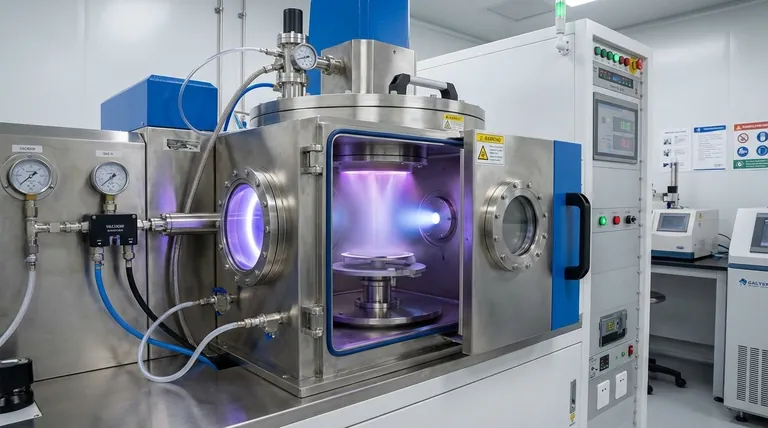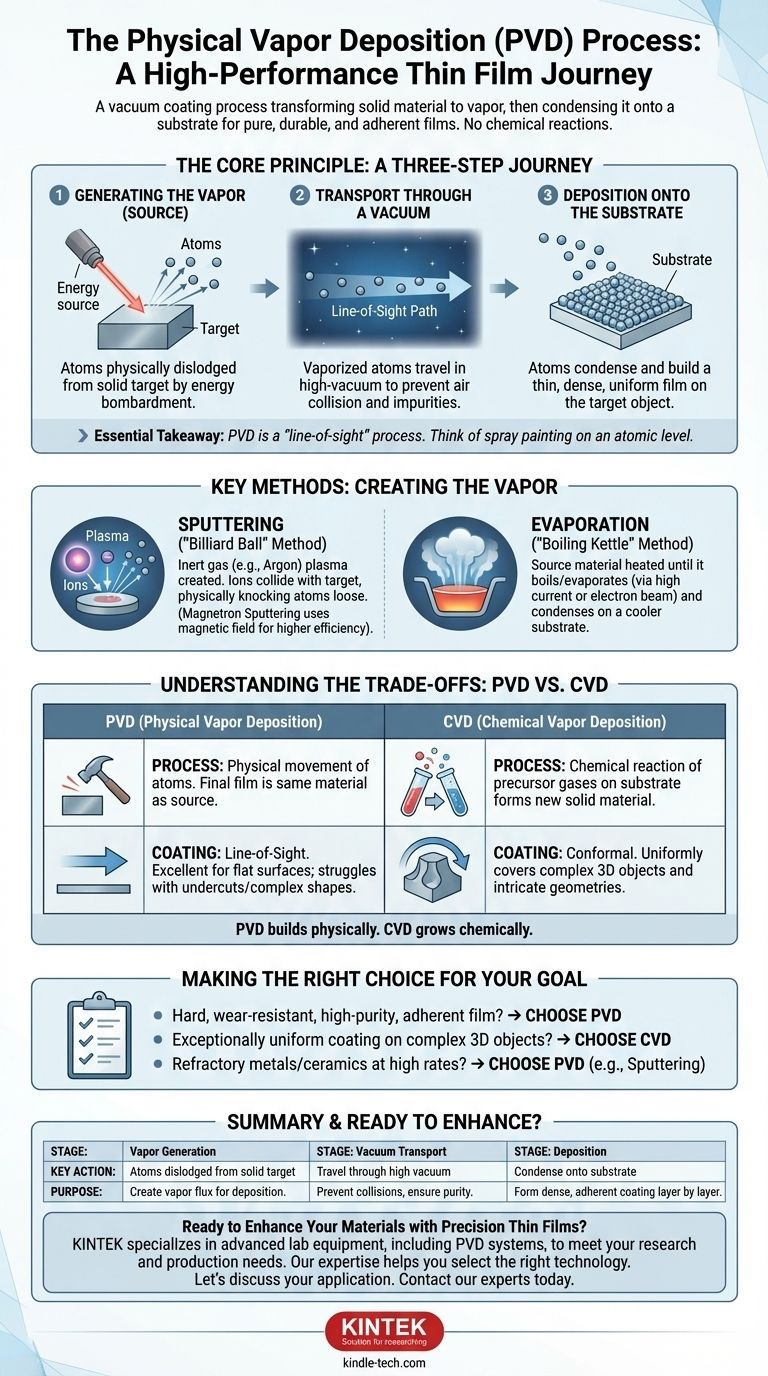본질적으로 물리 기상 증착(PVD)은 진공 코팅 공정입니다. 이 공정은 고체 재료를 증기로 변환하고, 진공을 통해 운반한 다음, 대상 물체의 표면에 응축시켜 고성능 박막을 형성합니다. 이 전체 공정은 순전히 물리적이며, 고체에서 기체로, 다시 고체로 상태 변화를 포함하며, 기판 자체에서는 화학 반응이 일어나지 않습니다.
핵심은 PVD가 근본적으로 "직선 시야(line-of-sight)" 공정이라는 것입니다. 원자 수준의 스프레이 페인팅과 같다고 생각해보세요. 원자는 소스에서 물리적으로 떨어져 나와 진공을 통해 직선으로 이동하여 표면을 코팅하며, 그 결과 극도로 순수하고 내구성이 뛰어나며 접착력이 좋은 필름이 생성됩니다.

핵심 원리: 3단계 여정
PVD 공정은 특정 기술에 관계없이 진공 챔버 내에서 일련의 기본적인 사건을 따릅니다. 이러한 단계를 이해하는 것이 PVD가 독특한 결과를 달성하는 방식을 파악하는 데 중요합니다.
1단계: 증기 생성
첫 번째 단계는 고체 소스 재료(종종 "타겟"이라고 불림)에서 증기를 생성하는 것입니다. 이는 재료에 에너지를 가하여 원자 또는 원자 그룹이 표면에서 떨어져 나가도록 함으로써 달성됩니다.
2단계: 진공을 통한 운송
이러한 해방된 원자들은 고진공 챔버를 통해 이동합니다. 진공은 증기화된 원자와 충돌하여 산란시키고 최종 필름에 불순물을 유입시킬 수 있는 공기 분자를 제거하는 데 중요합니다.
3단계: 기판에 증착
증기화된 원자가 "기판"으로 알려진 대상 물체에 도달하면 다시 고체 상태로 응축됩니다. 이 응축은 층별로 쌓여 기판 표면에 얇고 밀도가 높으며 매우 균일한 코팅을 형성합니다.
물리 기상 증착의 주요 방법
원리는 동일하지만, 초기 증기를 생성하는 두 가지 주요 방법이 있습니다. 선택하는 방법은 소스 재료와 원하는 필름 특성에 따라 달라집니다.
스퍼터링 ("당구공" 방법)
스퍼터링에서는 챔버에 아르곤과 같은 불활성 가스가 채워집니다. 강력한 전기장이 이 가스에 에너지를 공급하여 양전하를 띤 이온의 빛나는 플라즈마를 생성합니다.
이 이온들은 음전하를 띤 소스 재료(타겟)를 향해 가속됩니다. 이들은 타겟과 매우 강하게 충돌하여 당구공이 당구대 위의 공들을 깨뜨리는 것처럼 원자들을 물리적으로 튕겨냅니다.
일반적인 변형은 마그네트론 스퍼터링으로, 자기장을 사용하여 플라즈마를 타겟 근처에 가둡니다. 이는 스퍼터링 공정의 효율성을 극적으로 증가시켜 더 빠른 증착 속도를 가져옵니다.
증발 ("끓는 주전자" 방법)
열 증발은 더 간단한 방법입니다. 소스 재료는 진공 챔버에서 가열되어 문자 그대로 끓어 증기로 변합니다.
이는 종종 재료에 높은 전류를 통과시키거나 전자빔을 사용하여 가열함으로써 이루어집니다. 이 증기는 진공을 통해 이동하여 더 차가운 기판에 응축되며, 주전자에서 나오는 증기가 차가운 창문에 응축되는 것과 매우 유사합니다.
장단점 이해: PVD vs. CVD
PVD를 진정으로 이해하려면, 그 대응물인 화학 기상 증착(CVD)과 비교하는 것이 유용합니다. 둘 다 박막을 생성하지만, 그 메커니즘은 근본적으로 다릅니다.
공정: 물리적 vs. 화학적
PVD는 소스에서 기판으로 원자를 물리적으로 이동시킵니다. 최종 필름의 재료는 소스 재료와 동일합니다.
CVD는 대조적으로 전구체 가스를 챔버에 도입합니다. 그런 다음 기판 표면에서 화학 반응이 유도되어 가스가 분해되고 완전히 새로운 고체 재료가 필름으로 형성됩니다.
코팅 특성: 직선 시야 vs. 등각
PVD 원자는 직선으로 이동하기 때문에 직선 시야(line-of-sight) 공정입니다. 평평한 표면이나 물체의 노출된 면을 코팅하는 데 탁월하지만, 언더컷이나 복잡한 형상의 내부를 코팅하는 데는 어려움이 있습니다.
CVD 가스는 모든 노출된 표면에서 흐르고 반응할 수 있으므로, 가장 복잡하고 정교한 형상까지 균일하게 덮는 매우 등각(conformal) 코팅을 생성합니다.
작동 조건: 재료 및 온도
PVD는 많은 금속, 합금 및 세라믹을 포함하여 녹는점이 매우 높은 재료를 증착하는 데 탁월하며, 이러한 재료는 열만으로는 증기화하기 어렵습니다.
CVD 공정은 다용도이지만, 적절한 휘발성 전구체 화학 물질의 가용성에 의존하며, 기판 표면에서 필요한 화학 반응을 시작하기 위해 고온이 필요할 수 있습니다.
목표에 맞는 올바른 선택
올바른 증착 방법을 선택하려면 원하는 결과와 관련하여 각 공정의 핵심 강점을 이해해야 합니다.
- 도구에 단단하고 내마모성 코팅 또는 우수한 접착력을 가진 고순도 금속 필름이 주요 초점인 경우: PVD가 거의 항상 우월한 선택입니다.
- 내부 튜브 또는 마이크로 전자 장치와 같은 복잡한 3차원 물체 위에 예외적으로 균일한 코팅을 생성하는 것이 주요 초점인 경우: CVD의 등각층 생성 능력이 필수적입니다.
- 산업 응용 분야에서 내화 금속 또는 특정 세라믹을 높은 속도로 증착하는 것이 주요 초점인 경우: 마그네트론 스퍼터링과 같은 PVD 기술이 산업 표준입니다.
궁극적으로 올바른 기술을 선택하는 것은 PVD가 물리적으로 필름을 만들고, CVD가 화학적으로 필름을 성장시킨다는 것을 이해하는 것에서 시작됩니다.
요약표:
| 공정 단계 | 주요 작업 | 목적 |
|---|---|---|
| 1. 증기 생성 | 고체 타겟(소스 재료)에서 원자가 물리적으로 떨어져 나옵니다. | 증착을 위한 증기 흐름을 생성합니다. |
| 2. 진공 운송 | 해방된 원자가 고진공 환경을 통해 직선으로 이동합니다. | 공기 분자와의 충돌을 방지하여 순도와 직접적인 이동을 보장합니다. |
| 3. 증착 | 증기화된 원자가 기판 표면에 응축되어 박막을 형성합니다. | 밀도가 높고 접착력이 좋으며 고성능 코팅을 층별로 형성합니다. |
| 일반적인 방법 | 스퍼터링 (원자 충돌) & 증발 (열적 끓음). | 초기 증기 생성 단계를 달성하기 위한 다양한 기술. |
정밀 박막으로 재료를 향상시킬 준비가 되셨습니까?
극도의 경도, 높은 순도 또는 특정 전기적 특성과 같은 원하는 코팅 특성을 달성하려면 올바른 증착 기술을 선택하는 것이 중요합니다. PVD 공정은 내구성이 뛰어나고 내마모성 코팅 및 우수한 접착력을 가진 고순도 금속 필름을 생성하는 데 이상적입니다.
KINTEK은 특정 연구 및 생산 요구 사항을 충족하는 PVD 시스템을 포함한 고급 실험실 장비를 전문으로 합니다. 당사의 전문 지식은 귀하의 프로젝트 성공을 보장하기 위해 스퍼터링이든 증발이든 올바른 기술을 선택하는 데 도움이 됩니다.
귀하의 응용 분야에 대해 논의해 봅시다. 오늘 저희 전문가에게 연락하여 귀하의 실험실에 완벽한 PVD 솔루션을 찾으십시오.
시각적 가이드

관련 제품
- RF PECVD 시스템 고주파 플라즈마 강화 화학 기상 증착 RF PECVD
- 고온 응용 분야를 위한 몰리브덴 텅스텐 탄탈 증발 도가니
- 반구형 바닥 텅스텐 몰리브덴 증착 보트
- 화학 기상 증착 CVD 장비 시스템 챔버 슬라이드 PECVD 튜브로 액체 기화기 PECVD 기계
- 박막 증착용 알루미늄 코팅 세라믹 증착 도가니



















